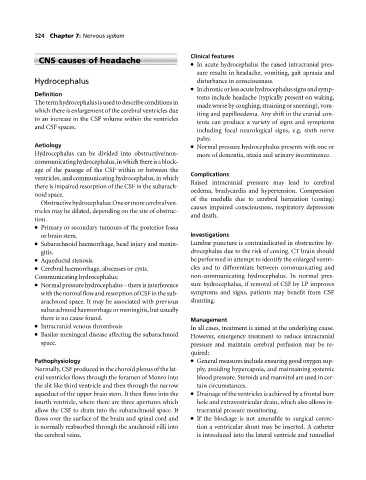Page 328 - Medicine and Surgery
P. 328
P1: FAW
BLUK007-07 BLUK007-Kendall May 25, 2005 18:18 Char Count= 0
324 Chapter 7: Nervous system
Clinical features
CNS causes of headache In acute hydrocephalus the raised intracranial pres-
sure results in headache, vomiting, gait apraxia and
Hydrocephalus disturbance in consciousness.
Inchronicorlessacutehydrocephalussignsandsymp-
Definition
toms include headache (typically present on waking,
Thetermhydrocephalusisusedtodescribeconditionsin
made worse by coughing, straining or sneezing), vom-
which there is enlargement of the cerebral ventricles due
iting and papilloedema. Any shift in the cranial con-
to an increase in the CSF volume within the ventricles
tents can produce a variety of signs and symptoms
and CSF spaces.
including focal neurological signs, e.g. sixth nerve
palsy.
Aetiology Normal pressure hydrocephalus presents with one or
Hydrocephalus can be divided into obstructive/non- more of dementia, ataxia and urinary incontinence.
communicatinghydrocephalus,inwhichthereisablock-
age of the passage of the CSF within or between the
Complications
ventricles, and communicating hydrocephalus, in which
Raised intracranial pressure may lead to cerebral
there is impaired resorption of the CSF in the subarach-
oedema, bradycardia and hypertension. Compression
noid space.
of the medulla due to cerebral herniation (coning)
Obstructivehydrocephalus:Oneormorecerebralven-
causes impaired consciousness, respiratory depression
tricles may be dilated, depending on the site of obstruc-
and death.
tion.
Primary or secondary tumours of the posterior fossa
or brain stem. Investigations
Subarachnoid haemorrhage, head injury and menin-
Lumbar puncture is contraindicated in obstructive hy-
gitis. drocephalus due to the risk of coning. CT brain should
Aqueductal stenosis.
be performed in attempt to identify the enlarged ventri-
Cerebral haemorrhage, abscesses or cysts.
cles and to differentiate between communicating and
Communicating hydrocephalus: non-communicating hydrocephalus. In normal pres-
Normal pressure hydrocephalus – there is interference
sure hydrocephalus, if removal of CSF by LP improves
withthenormalflowandresorptionofCSFinthesub- symptoms and signs, patients may benefit from CSF
arachnoid space. It may be associated with previous shunting.
subarachnoid haemorrhage or meningitis, but usually
there is no cause found. Management
Intracranial venous thrombosis In all cases, treatment is aimed at the underlying cause.
Basilar meningeal disease affecting the subarachnoid However, emergency treatment to reduce intracranial
space. pressure and maintain cerebral perfusion may be re-
quired:
Pathophysiology General measures include ensuring good oxygen sup-
Normally, CSF produced in the choroid plexus of the lat- ply, avoiding hypercapnia, and maintaining systemic
eral ventricles flows through the foramen of Monro into blood pressure. Steroids and mannitol are used in cer-
the slit like third ventricle and then through the narrow tain circumstances.
aqueduct of the upper brain stem. It then flows into the Drainage of the ventricles is achieved by a frontal burr
fourth ventricle, where there are three apertures which hole and extraventricular drain, which also allows in-
allow the CSF to drain into the subarachnoid space. It tracranial pressure monitoring.
flows over the surface of the brain and spinal cord and If the blockage is not amenable to surgical correc-
is normally reabsorbed through the arachnoid villi into tion a ventricular shunt may be inserted. A catheter
the cerebral veins. is introduced into the lateral ventricle and tunnelled

